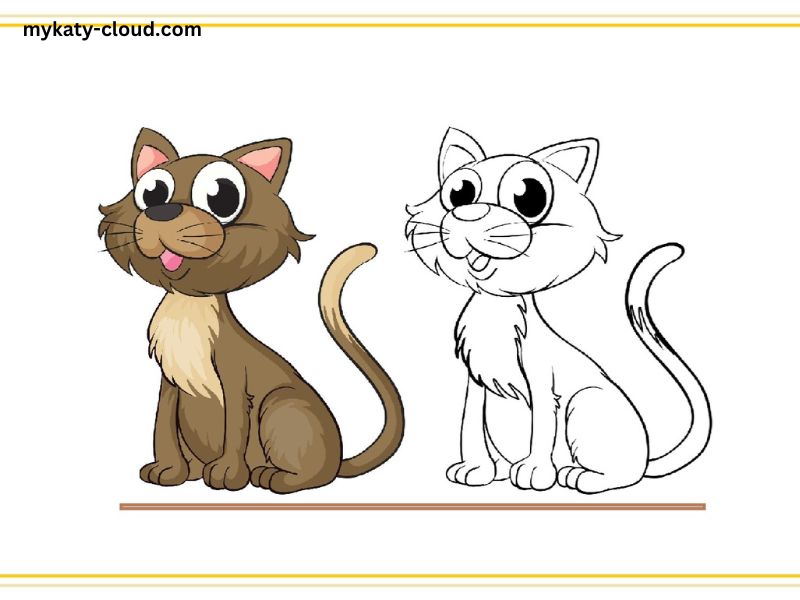Drawing cats can be a delightful and rewarding experience for artists of all skill levels. Whether you’re a beginner looking to hone your skills or an experienced artist seeking new techniques, capturing the beauty and grace of these creatures offers a unique challenge. This article provides a comprehensive guide to drawing cats, covering everything from basic shapes to advanced techniques.
Understanding Cat Anatomy
Before you start drawing, it’s essential to understand the basic anatomy of cats. This knowledge will help you capture their unique proportions and movements.
Basic Cat Anatomy
- Head: The head of a cat is usually rounded with a slightly elongated muzzle. The ears are triangular and can vary in size depending on the breed.
- Body: Cats have a flexible spine, allowing for graceful movements. Their bodies can vary from slender to stocky, depending on the breed.
- Limbs: Cats have four limbs, with strong, muscular legs that enable them to leap and run. Their paws are relatively small and have retractable claws.
- Tail: The tail is an extension of the spine and plays a vital role in balance and communication. It can be long or short, bushy or sleek, depending on the breed.
- Eyes: Cat eyes are large and expressive, often giving them a mystical appearance. Their pupils can change dramatically based on lighting and mood.
Tools and Materials
To begin your drawing journey, gather the necessary tools and materials:
- Pencils: A range of pencils (HB, 2B, 4B, 6B) will allow for various shading techniques.
- Erasers: Both a kneaded eraser and a vinyl eraser are helpful for correcting mistakes and adding highlights.
- Paper: Choose a smooth drawing paper or sketchbook that suits your style.
- Reference Images: Use high-quality images of cats for inspiration. Pay attention to different breeds, colors, and poses.
- Blending Tools: Blending stumps or tortillons can help achieve smooth transitions in shading.
Basic Drawing Techniques
Step 1: Basic Shapes
Start by sketching the basic shapes that make up a cat’s body. Use light, loose lines to create a rough outline.
- Head: Draw a circle for the head, adding a smaller oval for the muzzle.
- Body: Use a larger oval for the body. Keep in mind the proportion; a typical cat’s body is about 1.5 times the length of its head.
- Limbs: For the legs, sketch simple cylindrical shapes extending from the body. Don’t forget the paws, which can be drawn as small ovals at the ends of the limbs.
- Tail: Draw a long, tapering shape for the tail, varying the thickness based on the breed.
Step 2: Refine the Shapes
Once you’re satisfied with the basic shapes, refine them into more recognizable forms. Focus on the unique features of the cat you’re drawing.
- Facial Features: Add details such as the eyes, nose, and mouth. Cats have distinct facial expressions that can convey a wide range of emotions.
- Ears: Refine the shape of the ears, adding details like the inner ear and any fur texture.
- Body Contours: Smooth out the body outline to reflect the cat’s natural curves and musculature.
Step 3: Add Details
Now it’s time to add the details that bring your drawing to life.
- Fur Texture: Use short, quick strokes to create the illusion of fur. Pay attention to the direction of fur growth, which often follows the contours of the body.
- Eyes: Spend extra time on the eyes, as they are the focal point of your drawing. Capture the reflective quality and depth by shading the iris and leaving a small highlight.
- Paws and Claws: Add detail to the paws, showing the pads and retractable claws.
Step 4: Shading
Shading is crucial for adding depth and dimension to your drawing.
- Light Source: Determine where your light source is coming from. This will influence where you place your shadows.
- Layering: Start with light shading and gradually build up darker tones. Use blending tools to smooth out transitions between light and dark areas.
- Contrast: Enhance contrast by darkening the shadows and brightening the highlights, giving your drawing a more three-dimensional appearance.
Advanced Techniques
Once you’ve mastered the basics, consider exploring more advanced techniques to elevate your cat drawings.
1. Gesture Drawing
Gesture drawing involves capturing the essence of a cat’s movement quickly. This technique is excellent for understanding how cats move and express themselves.
- Quick Sketches: Spend a few minutes sketching cats in various poses. Focus on the overall shape and movement rather than details.
- Dynamic Poses: Experiment with different poses, such as a cat stretching, pouncing, or lounging. This will help you understand the flexibility of their bodies.
2. Color Techniques
If you’re interested in adding color to your drawings, explore various coloring techniques.
- Colored Pencils: Use colored pencils to add depth and vibrancy. Layer colors to achieve a realistic fur effect.
- Watercolor: Watercolors can create soft, blended effects that mimic the softness of fur. Use a wet-on-wet technique for a dreamy, fluid appearance.
- Digital Art: If you’re drawing digitally, experiment with brushes and textures to create lifelike fur and shading effects.
3. Experimenting with Styles
Don’t hesitate to explore different artistic styles when drawing cats. From realistic to cartoonish, each style offers unique challenges and creative opportunities.
- Realism: Focus on accurately representing the cat’s features and proportions, paying close attention to details like fur patterns and eye reflections.
- Cartoon: Simplify shapes and exaggerate features for a playful look. This style allows for more creativity in expressions and poses.
- Abstract: Use shapes, colors, and lines to convey the essence of a cat without strict adherence to realism. This approach can lead to interesting and unique artworks.
Final Tips for Drawing Cats
- Practice Regularly: The more you draw, the better you’ll become. Make it a habit to sketch cats regularly.
- Study Real Cats: Observe real cats in various settings. Pay attention to their movements, expressions, and interactions.
- Join a Community: Engage with fellow artists online or in local art groups. Sharing your work and receiving feedback can be incredibly beneficial.
- Be Patient: Mastering the art of drawing cats takes time. Don’t rush the process; enjoy the journey of improvement.
- Have Fun: Remember that drawing should be enjoyable. Experiment with different techniques and styles, and don’t be afraid to make mistakes.
Conclusion
Drawing cats is an art form that allows you to express creativity while capturing the unique beauty of these beloved animals. By understanding cat anatomy, mastering basic techniques, and exploring advanced methods, you can create stunning representations of felines. Whether you’re sketching for fun or developing a portfolio, the skills you develop through drawing cats will enhance your overall artistic abilities. So grab your pencils, find a cozy spot, and let the inspiration flow!



